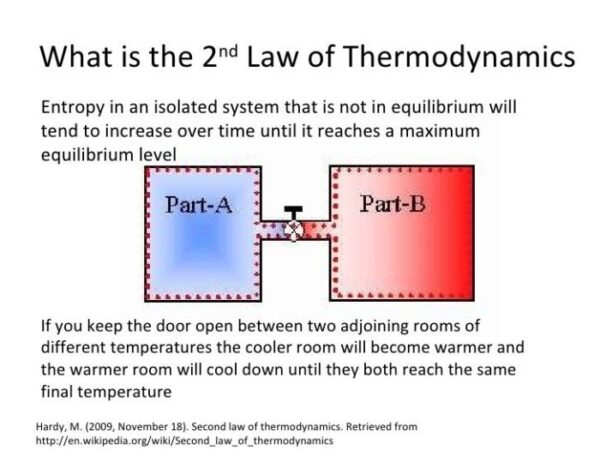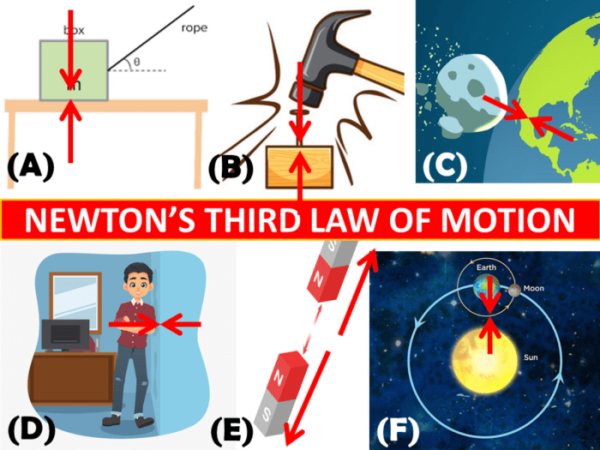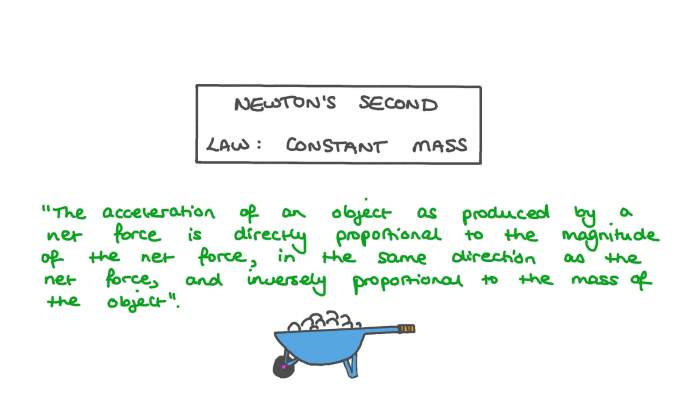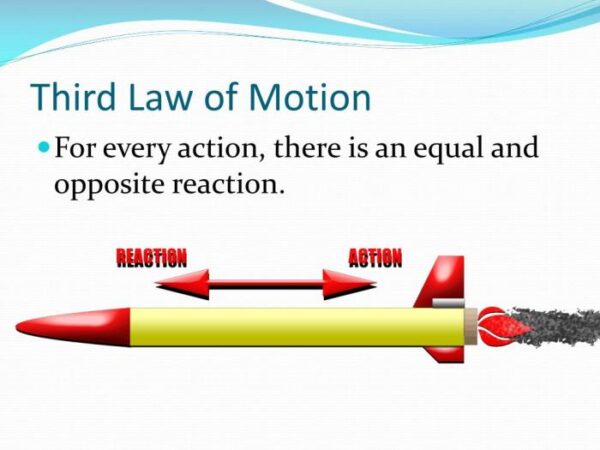
What’s Newton’s First Law of Motion? It’s a fundamental concept in physics that explains why objects at rest tend to stay at rest, and objects in motion tend to stay in motion. This law, often referred to as the Law of Inertia, was formulated by Sir Isaac Newton, a renowned physicist and mathematician, in the 17th century. His groundbreaking work revolutionized our understanding of motion and its underlying principles.
Newton’s First Law is a cornerstone of classical mechanics, providing a framework for understanding the behavior of objects under the influence of forces. It lays the foundation for understanding more complex concepts in physics, such as momentum, energy, and gravity. This law has far-reaching implications, influencing everything from the design of vehicles and buildings to the understanding of celestial bodies and the universe itself.
Applications of Newton’s First Law
Newton’s First Law of Motion, also known as the Law of Inertia, governs the behavior of objects in motion and at rest. It explains why objects tend to resist changes in their motion and provides a fundamental framework for understanding various physical phenomena.
Examples of Objects at Rest and in Motion
Objects at rest remain at rest, and objects in motion continue in motion with the same speed and direction unless acted upon by an unbalanced force. This principle is evident in numerous everyday scenarios:
- A book resting on a table will stay at rest until someone picks it up or pushes it.
- A car traveling at a constant speed on a straight road will continue moving at that speed unless brakes are applied, the steering wheel is turned, or an external force like a collision occurs.
- A ball rolling on a smooth surface will keep rolling in the same direction until friction slows it down or something stops it.
Inertia’s Impact on Everyday Objects and Situations
Inertia, the tendency of an object to resist changes in its state of motion, is a fundamental concept that affects our daily experiences:
- When a car suddenly accelerates, passengers feel pushed back against their seats. This is due to their inertia; their bodies tend to stay at rest while the car accelerates forward.
- When a car suddenly brakes, passengers lurch forward. This is because their bodies continue moving forward due to inertia while the car decelerates.
- It is harder to push a heavy box than a light one because the heavier box has more inertia and resists changes in its motion more strongly.
- A hammer hitting a nail drives the nail into the wood because the hammer’s inertia transfers its momentum to the nail.
Newton’s First Law in Engineering and Transportation
Newton’s First Law plays a crucial role in various engineering and transportation applications:
- Vehicle Design: Engineers consider inertia when designing vehicles to ensure stability and safety. Inertia plays a role in the design of crumple zones in cars, which absorb energy during collisions to protect occupants.
- Spacecraft Design: In spacecraft design, inertia is a critical factor. Satellites and rockets need to overcome inertia to change their trajectory or escape Earth’s gravity.
- Transportation Systems: In transportation systems, inertia is a key consideration in the design of tracks, roads, and bridges. These structures must be able to withstand the forces generated by moving vehicles and the inertia of their passengers.
Inertia and its Implications
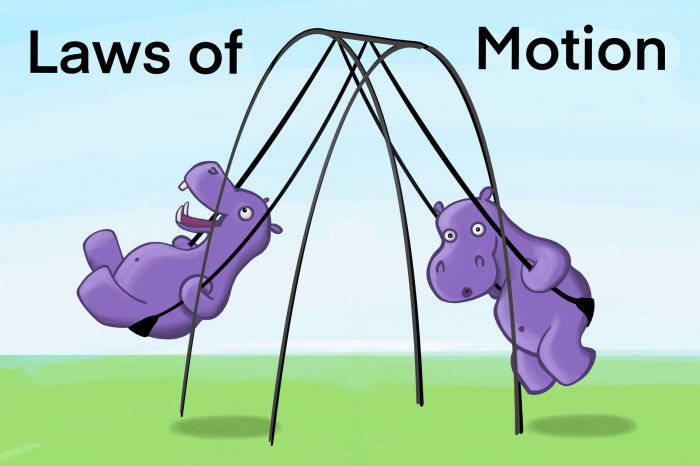
Inertia is a fundamental concept in physics that describes an object’s tendency to resist changes in its state of motion. It’s the inherent property of matter to remain at rest or continue moving in a straight line at a constant speed unless acted upon by an external force. Inertia is directly proportional to an object’s mass; the more massive an object, the greater its inertia. This means it requires a greater force to change its motion.
The Significance of Inertia
Inertia is a crucial concept in understanding the behavior of objects in the universe. It explains why objects at rest remain at rest, and objects in motion continue moving at a constant velocity unless acted upon by a force. It also forms the foundation for Newton’s First Law of Motion, which states that an object at rest will stay at rest and an object in motion will stay in motion with the same speed and in the same direction unless acted upon by an unbalanced force.
Comparing Inertia with Other Forces
Inertia is not a force itself; it’s the property of an object that resists forces. Forces, on the other hand, are external influences that can change an object’s state of motion.
Comparison of Inertia and Forces
- Inertia is a property of matter that resists changes in motion, while forces are external influences that can cause changes in motion.
- Inertia is a passive property, meaning it doesn’t actively do anything; it simply resists changes. Forces, on the other hand, are active and can cause changes in motion.
- Inertia is proportional to an object’s mass, while forces can be independent of mass (like gravity) or dependent on mass (like friction).
Limitations of Newton’s First Law
Newton’s First Law of Motion, while fundamental, has limitations in certain scenarios. It holds true in inertial frames of reference, which are frames that are not accelerating. However, in non-inertial frames, like a rotating or accelerating frame, the law doesn’t directly apply. In these cases, fictitious forces need to be introduced to account for the observed motion. For example, the Coriolis force, experienced by objects moving in a rotating frame, is a fictitious force that arises due to the frame’s rotation.
Visual Representations of Newton’s First Law

Visual representations can help us understand and remember concepts like Newton’s First Law of Motion. These visual aids make abstract ideas more concrete and relatable, allowing us to grasp the relationship between forces, motion, and inertia.
Examples of Objects at Rest and in Motion
Visualizing objects at rest and in motion, along with the forces acting upon them, is crucial to understanding inertia. The table below provides examples of objects in both states, highlighting the forces involved.
| Object | State | Forces Acting | Description |
|---|---|---|---|
| Book on a table | At rest | Gravity (downward), Normal force (upward) | The book is stationary because the forces acting on it are balanced. Gravity pulls the book down, and the table pushes back with an equal and opposite normal force. |
| Ball rolling on a flat surface | In motion | Gravity (downward), Normal force (upward), Friction (opposing motion) | The ball is moving because there is an unbalanced force acting on it. The initial push or force that started the ball rolling is no longer present. Friction, a force opposing the motion, eventually brings the ball to a stop. |
| Car traveling at a constant speed | In motion | Engine force (forward), Air resistance (backward), Friction (backward) | The car is moving at a constant speed because the forces acting on it are balanced. The engine force propels the car forward, while air resistance and friction oppose its motion. |
Comparing and Contrasting Inertia with Other Forces
Inertia is often confused with other forces, but it’s distinct. The following table compares and contrasts inertia with other forces.
| Characteristic | Inertia | Force |
|---|---|---|
| Definition | The tendency of an object to resist changes in its state of motion. | A push or pull that can change an object’s motion. |
| Nature | Not a force itself, but a property of matter. | An interaction that causes a change in motion. |
| Measurement | Measured by an object’s mass. | Measured in units of Newtons (N). |
| Examples | A heavy object is harder to move than a light object. | A person pushing a box, gravity pulling an apple to the ground. |
Relationship between Force, Mass, and Acceleration, What’s newton’s first law of motion
Newton’s Second Law of Motion states that the acceleration of an object is directly proportional to the net force acting on it and inversely proportional to its mass. This can be represented visually as follows:
F = ma
Where:
* F is the net force acting on the object
* m is the mass of the object
* a is the acceleration of the object
This formula implies that:
* A larger force will result in a greater acceleration.
* A larger mass will result in a smaller acceleration.
Visual representations of this relationship could include diagrams showing how the acceleration of an object changes with different forces and masses. For instance, a diagram could show a car accelerating faster when a larger force is applied to it, or a car accelerating slower when it has a larger mass.
Final Thoughts
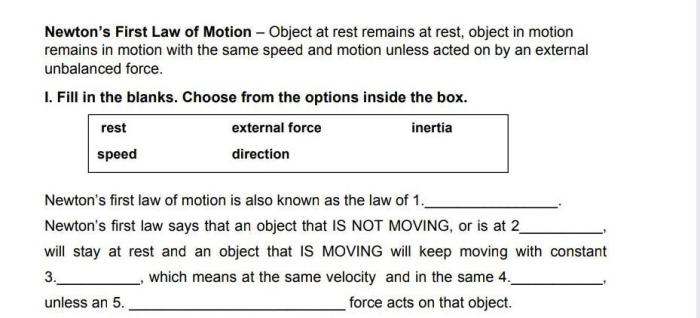
Newton’s First Law of Motion is a simple yet powerful principle that governs the behavior of objects in motion. It highlights the fundamental property of inertia, emphasizing that objects resist changes in their state of motion. Understanding inertia is crucial for comprehending how forces interact with objects, leading to a deeper appreciation of the world around us. This law serves as a foundational concept in physics, providing a framework for understanding the intricate dance of motion and its underlying principles.
Query Resolution: What’s Newton’s First Law Of Motion
What is the difference between inertia and momentum?
Inertia is a property of matter that resists changes in motion. Momentum, on the other hand, is a measure of an object’s mass and velocity. While inertia is a fundamental property, momentum is a quantity that can be calculated.
Does Newton’s First Law apply to all objects?
Newton’s First Law applies to all objects in the universe, regardless of their size or composition. However, at very high speeds, close to the speed of light, the laws of relativity become more relevant.
How does friction affect Newton’s First Law?
Friction is a force that opposes motion. It can cause objects to slow down or come to a stop, even in the absence of external forces. This means that friction can counteract the effects of inertia.
